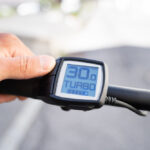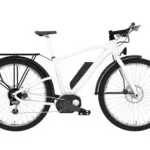The controller is regarded as the heart of an electric bike. It is responsible for connecting all other components, including the motor, battery, and throttle. It works by taking power from the battery and transferring it to the motor.
Just as humans face heart-related issues, electric bikes also face many problems associated with the controller. It is better to detect and mitigate these problems early to avoid damage to the bike.
This article discussed various problems that may arise in the bike’s controller and the possible ways to troubleshoot them
How Does An Electric Bike Controller Work?
The controller manages the pedal assist and throttle function of an e-bike. Pedal-assist and throttle mode are the two characteristic features of an electric bike, making them different from regular bikes.
Once you pull the throttle on an e-bike or turn on pedal-assist, the switch creates a full circuit. The controller connects this circuit from the battery to the motor, and a constant transfer of current takes place.
Electric Bike Controller Problems
“”What causes electric bike controller problems?” is the biggest question. Once the root cause of the problem is identified or detected, the problem is half solved.
Here are some of the causes:
Damage of power device
Different electric bikes have different power architecture depending on the type of motor. These days most electric bikes use the brushless DC motor (BLDC).
Although these synchronous motors are robust, there are some issues the controller may face due to it. Some of the possible reasons behind this are as follows:
- Low power to the battery
- Overloading of the motor.
- Any motor damage.
- Irrational power architecture design.
- Drive circuit damage due to voltage slumps or spikes.
- Loose device installation may cause shaking.
- Poor grades selection.
The controller’s internal power supply gets damaged.
The controller has a complex internal working mechanism. There are many complex paths involved inside the controller.
Following are a few reasons behind such damage:
- Short circuit in the peripheral unit of the controller.
- Internal route of the controller getting short-circuited.
- Cut out of the outer lead.
Controller’s fluctuating and irregular work
Controller’s functionality is affected by many potential factors. Any changes in this functioning environment may cause irregularities in the controller’s functioning. Some of these changes are as follows:
- Extreme temperature shifts in a drift environment.
- The local temperature of the device may get intensified if there is high power consumption in the controller.
- A lagging or low interaction between components of the controller.
Poor Wire Connections
The control signal might get lost entirely if the wires are defective or not correctly connected.
Some of the reasons behind poorly connected wires are as follows:
- Some of the wires might not be in their respective outlets.
- If the wires are not color-coded, they might be connected in the wrong slots.
- If the wires have loosened over time due to internal wear and tear.
Troubleshooting Controller Problems In Electric Bikes
There can be many minor and major problems in the controller of your electric bikes, as discussed above. These can be troubleshooting with a well-planned strategy.
Here is a simple step-by-step guide you can follow to either repair the controller or replace it altogether.
Observe the overall architecture
Different bikes have varying architecture according to which their structure is built. Here are a few things you must consider when it comes to selecting the right controller:
- Prefer a controller, which uses thick cables rather than ones that have cut corners in the wire it is connected to.
- If you have an option, go for a bulky radiator controller over a lighter one. The output may vary thermostatically.
- It is observed that wave welding products are in a way better than manually welded ones.
- Always go for a controller from a reputed company or brand rather than the one from a workshop. It may save you some money but won’t have a quality functioning.
Observe which controller gets hot faster
While choosing the controller, make sure you compare the effective rise in temperature between the new and the original one.
Here are some guidelines you must follow to have a proper comparison:
- Tear down both the controllers.
- The radiator has to be held up to be turned on so that you can check the top speed.
- Gently press the brakes for about 5 seconds.
- The moment you leave the brakes, a higher speed is reached. This process has to be done regularly so that you can detect the highest temperature of the radiator.
Once you are over with this process, you can infer that the lower the temperature better is the output. Post testing ensures that the MOS is fixed and the screws are tightened to avoid any damage.
Similarly, one can get an idea of the controller’s cooling design by comparing the radiator’s temperature.
Observe the ability to control the current
As discussed above, the controller’s prime function is to transfer the current from the battery to the motor for further operation.
The ability to control and regulate the current plays a crucial role here.
You can check this by following some simple steps given below:
- Make the necessary connections for the battery to function.
- Choose the short circuit’s output line and let the motor attain a relatively higher speed.
- This short circuit wire and battery’s anode are to be used multiple times to get a reliable output.
The lesser the MOS internal resistance, the higher is the short circuit’s direct current. This shows the controller’s ability to control the current.
In case of any damage, you can check the ability of the controller to bear short circuits. This will help you figure out the subtle difference between the abilities of the two controllers.
Also, this will give you a concrete idea of their software and hardware reliability design.
How To Check The Controller Of An Electric Bike?
The controllers used in electric bikes have very complicated wiring, which is not easy to test. If you want to check if the controller is working or not, you can check all the components connected to the controller and apply some logic elimination techniques. This will help you identify if there is any problem with the controller.
Following are some tips that can be used while checking the connected components:
- Check for the loose wires.
- Check if all the wires are connected in their respective colored outlets.
- If the power switch isn’t working, check if it uses any fuse. If it does, open the fuse to check if it is burnt.
- See if the throttle is getting engaged when the bike reaches walking-speed.
- Smell and touch to detect if any wires are melted down or burnt.
- If the motor is burnt, replace it; otherwise, it will cause damage to the controller.
Conclusion
Electric bikes are an economical and versatile source of mobility. But their functioning might degrade if their components have a problem.
All the components of an electric bike are connected via the controller. Thus any problem in these parts can cause damage to the controller and vice versa.
Using the useful tips and tricks given in this article, you can keep your controller trouble-free.





